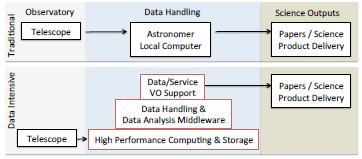ASTRO 3D telescopes are collecting large volumes of multi-dimensional datasets, while the Genesis Theoretical Simulations are producing prodigious amounts of theoretical data. These petabyte-scale datasets require sophisticated data management and access mechanisms, as well as new algorithms and visualisation tools to efficiently extract scientific information.
The Data Intensive Astronomy (DIA) Program, led by CIs Richard McDermid and Lister Staveley-Smith, facilitates better access to tools, technology, infrastructure and training for ASTRO 3D researchers working with large data sets and in High-Performance Computing (HPC) environments.
It does this by working with national infrastructure providers, and by the sharing of expertise between ASTRO 3D researchers. As much of the ASTRO 3D science involves world-leading surveys and large data sets, our ability to process our data in a timely and efficient manner is critical to our success.
How it fits together
We are implementing a layered “Data Fabric” plan based on the recommendation of the 2016-2025 Australian Astronomy Decadal Plan. With the three layers of this fabric, we aim to seamlessly join all ASTRO 3D survey and Genesis simulation data.



